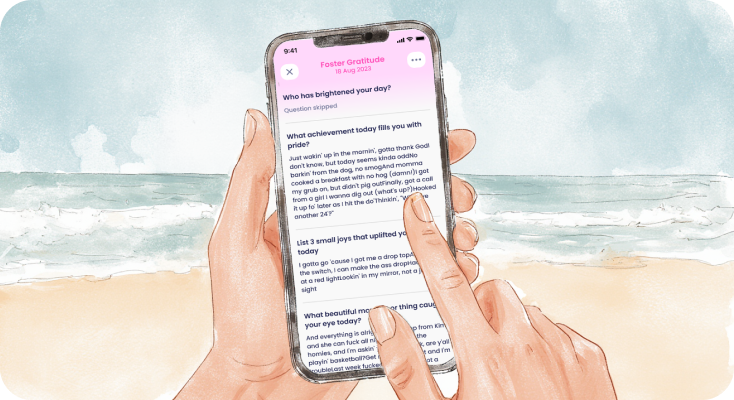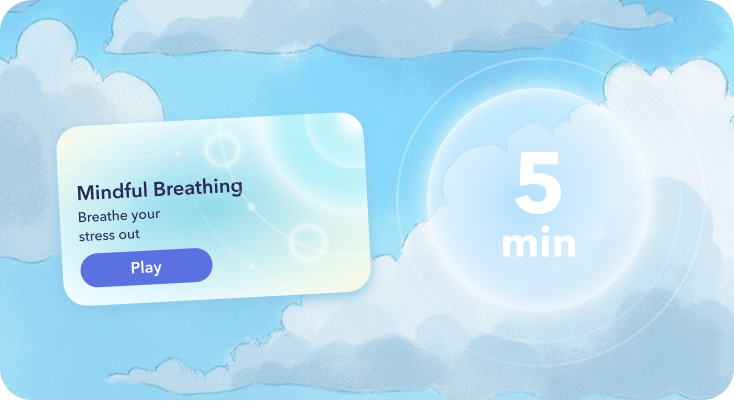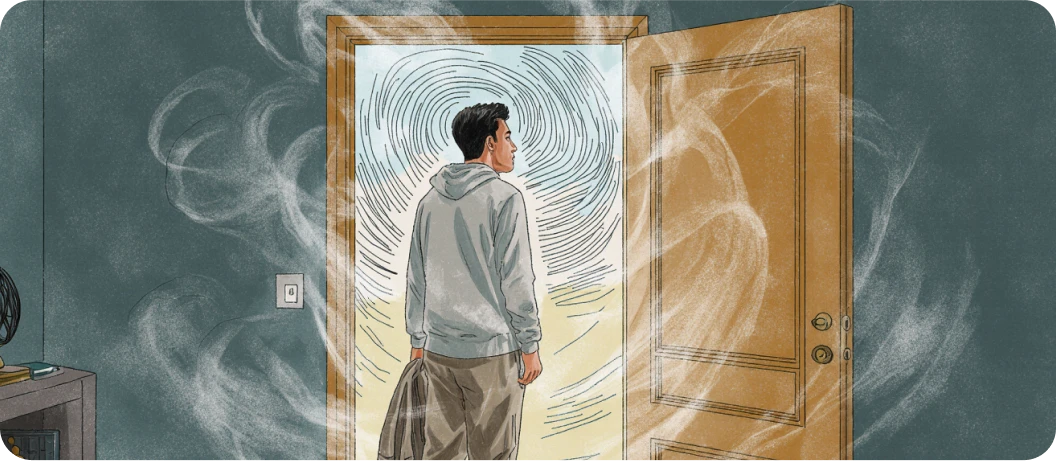Do you replay awkward moments from last week like they happened five minutes ago? Overanalyze every word in a text message before hitting send? Struggle to focus because your mind is paralyzed by your own racing thoughts?
Learning to calm your wandering mind is an important skill of psychological flexibility, and it can be trained. Find out how to get out of your head using mindfulness techniques and other practical tips.
You can start by taking an insightful Emotional Intelligence Test to understand how well you recognize and manage your own emotions. It’s a great first step to changing negative thought patterns, becoming more aware, and regaining control of your psychological well-being.
7 Effective Steps to Get Rid of Negative Thinking Patterns And Live in The Present Moment
You can turn down the volume of intrusive thoughts using the techniques below. At first, these persistent thoughts may not go away anytime soon, but you will not trust them as blindly as before.
1. Limit overstimulation
Sometimes, you may be in your head, thinking, “Why can’t I focus?” This may be because you’ve overstimulated your brain, according to a study on digital multitasking and hyperactivity [1]. Take breaks from social media, news, and music.
Begin with this simple exercise for your daily life:
- Set a reminder to spend 5–15 minutes doing nothing.
- Eliminate as many distractions as possible from your surroundings. Turn off your phone and other devices that generate sound or images to create space for clarity, focus, and calm.
- Just sit, breathe, and observe. No music, no notifications, no talking, no multitasking.
Even a 5-minute break can interrupt the endless cycle of overthinking, rumination, or planning.
Do you find it difficult to just sit and do nothing without checking your phone or listening to music?
2. Become aware of your anxious thoughts
Before you can get out of your own head, you first need to build understanding through the process of awareness. The more aware you become, the more peace and joy you may experience in your life, according to research on effects of self-awareness [2].
- Label the thought
When you catch yourself struggling with your thoughts, try to label them. For example: “worries about the future,” “thoughts about uncertainty,” “thoughts about past,” “thoughts about ‘what if a bad thing happens’,” “worries about relationships,” “financial worries”.

- Journal your thoughts
Write them down to clearly identify and name them. For this, you can use Breeze journaling. Simply open the app and create a quick note describing what’s on your mind. Don’t worry about making it perfect, just write what you’re thinking and how it makes you feel.
- Practice journaling every time your mind wanders
Over time, this practice can help you recognize recurring thought patterns and reduce anxiety and emotional overwhelm. Journaling turns mental noise into something concrete and manageable. Even a few minutes a day can make a meaningful difference in how you feel your feelings.

3. Recognize automatic negative thoughts (ANTs)
ANTs are automatic, often irrational negative thoughts, typically associated with anger, fear, anxiety, or self-doubt. Here’s what to do if ANTs start to run through your mind:
- Examine the trigger
Analyze the circumstances that are upsetting you and write down the first thought that appears in your mind. What are the reasons behind these thoughts? What happened just before they came up? Was there a comment, an email, a memory, or a task you were avoiding? Identify what increased your stress levels.
- Step back and break down the emotions you’re experiencing
What are you telling yourself about the situation? For example, “Why am I such a failure?” or “They’re going to be disappointed in me.” Make sure you label an actual feeling word and not just the thoughts. Your emotions influence your thoughts and vice versa, so it’s important to be able to label them separately.
- Label the thought pattern
Try to recognize the type of negative thinking at play. Some common ANTs include:
- Catastrophizing: expecting the worst-case scenario.
- Mind reading: assuming you know what others think.
- All-or-nothing thinking: seeing things as black or white, success or failure.
- Overgeneralizing: using words like “always” or “never.”
- Find an alternative to your original thought
For example, instead of jumping straight to, “This is going to be a disaster,” try something like, “I’m nervous, but I’m preparing well and doing my best.”
Expert Insight
There are many things that can distract us from the present moment. A big way to tell is through your attention. If you are not able to pay attention to the present, it is likely because you are more focused on your thoughts or distracted by internal dialogue.
Hannah Schlueter
Mental health professional
4. Practice mindfulness
Mindfulness is a powerful practice that improves self-control and emotional regulation, builds emotional resilience, and psychological flexibility [3]. With practice, you may understand that intrusive thoughts go away as easily as they come. The point is not to let them control you.
The more you develop negative thoughts, thinking over details and solutions, the more you increase their importance and weight. Here’s a simple way to start practicing mindfulness activities:
1. Take a few minutes to sit quietly, observing how different thoughts appear in your head
2. Try not to chase them, but release them, focusing on your breath.
3. Next, try reading the suggested meditations below or your own versions of them:
- As I breathe in, I am aware of my thoughts.
- As I breathe out, I know that they are impermanent.
- As I breathe in, I reflect on the ability to let go of thoughts.
- As I breathe out, I feel the joy of letting go of my thoughts.
Breeze mindful breathing can help you calm your mind, reduce stress, and bring your focus back to the present moment. You don’t have to try to control your breathing, just focus on the air coming in and out on its own. The slower you breathe, the better you will feel with each inhalation and exhalation [4].

Or, when intrusive thoughts creep into your head, just imagine that it is unsolicited advice from a stranger, which you are not going to follow. Say “thank you” to this thought and move on. This may help you control and manage your thoughts and emotions.
5. Meditate
Here’s how to meditate to reconnect with yourself and stop the constant stream of thoughts:
1. Create your calm zone
Find a cozy spot. It could be your bed, your office chair, or a sunny patch on the floor. Sit comfortably, spine tall but relaxed. Close your eyes if that feels safe.
2. Breathe like it matters
Take a long, slow breath in through your nose. Feel your lungs expand. Hold it for a second. Now, exhale through your mouth. Do this a few times to settle in.
3. Tune in to your breath
Let your breath be your anchor. Feel the rise and fall of your belly. The cool air coming in… the warm air going out, and your body feels it. Don’t try to breathe a special way, just notice it.
4. Watch your thoughts drift by
If your mind wanders, imagine the thoughts as clouds floating across the sky. Acknowledge it, then return to your breath.
5. Close with a moment of gratitude
When your timer goes off (start with 5 minutes), take one more deep breath and open your eyes. Thank yourself for taking this time. You just meditated.
6. Check each thought for its “durability”
When you find yourself caught up in worry or overthinking about cheating on, try to mentally move away from what’s happening and ask yourself: Will this still matter in 10 minutes? 10 hours? 10 days? 10 months?
Let’s say you’re upset after a difficult work phone call. Picture the moment right after it ends. You might feel tense or unsettled for the next 10 minutes or maybe even for a few hours, but by tomorrow, chances are you’ll be focused on something else entirely.
Such a test may allow you to understand which problems are really worth the emotional costs and which are being blown out of proportion: Through the lens of time, you may see that worrying doesn’t provide any real benefit; it just takes away resources that could be directed toward something more productive, relaxing, or valuable.
7. Incorporate affirmations for mental health into your daily routine
According to research on self-affirmation, it activates parts of the brain linked to self-reflection and rewards, and it becomes even stronger when we focus on positive future goals [5].
By regularly repeating positive affirmations, you may reduce the impact of negative self-talk and boost your sense of motivation and self-worth. Instead of getting stuck in cycles of doubt or criticism, try saying or writing phrases like:
- My thoughts are not facts. I choose where to place my focus.
- Not everything needs to be solved right now.
- Worry does not define me. Calm is always available.
- I don’t need all the answers to move forward.
Start small: choose one or two affirmations and repeat them in the morning, during a break, or before bed. Or, you can use the Breeze app’s daily affirmations to receive mindful prompts and personalized supportive phrases.

Sources
- Hasan MK. “Digital multitasking and hyperactivity: unveiling the hidden costs to brain health.” Ann Med Surg (Lond). 2024
- Sutton A. Measuring the Effects of Self-Awareness: Construction of the Self-Awareness Outcomes Questionnaire. November 2016
- Daphne M. Davis, PhD, and Jeffrey A. Hayes, PhD. “What are the benefits of mindfulness?” July/August 2012
- Bentley TGK, D’Andrea-Penna G, Rakic M, Arce N, LaFaille M, Berman R, Cooley K, Sprimont P. “Breathing Practices for Stress and Anxiety Reduction: Conceptual Framework of Implementation Guidelines Based on a Systematic Review of the Published Literature. Brain Sci.” 2023
- Cascio CN, O’Donnell MB, Tinney FJ, Lieberman MD, Taylor SE, Strecher VJ, Falk EB. Self-affirmation activates brain systems associated with self-related processing and reward and is reinforced by future orientation. November 2015
Disclaimer
This article is for general informative and self-discovery purposes only. It should not replace expert guidance from professionals.
Any action you take in response to the information in this article, whether directly or indirectly, is solely your responsibility and is done at your own risk. Breeze content team and its mental health experts disclaim any liability, loss, or risk, personal, professional, or otherwise, which may result from the use and/or application of any content.
Always consult your doctor or other certified health practitioner with any medical questions or concerns
Breeze articles exclusively cite trusted sources, such as academic research institutions and medical associations, including research and studies from PubMed, ResearchGate, or similar databases. Examine our subject-matter editors and editorial process to see how we verify facts and maintain the accuracy, reliability, and trustworthiness of our material.
Was this article helpful?




